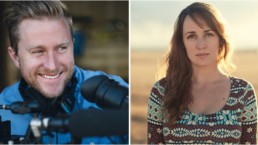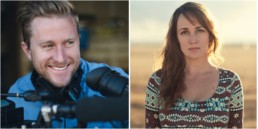Co-Directors Aaron and Amanda Kopp Talk Artistic Choices in ‘Liyana’
"When collaboration works, it's a thing of magic." -Aaron Kopp
In an orphanage in the southern part of the African country of Swaziland, students are brought together and given an extraordinary project.
They are going to forge the story of Liyana, a fictional heroine born from their collective experiences and imaginations. The film of the same title, “Liyana,” is both a telling of this original story, as well as the non-fiction story of its young creators who made it up. In our exclusive interview with the filmmakers, which took place just days before the film went on the win the Best Documentary award at the LA Film Festival, Aaron Kopp and Amanda Kopp talked about artistic choices in multimedia mixed formats, the process in how the kids created the story of “Liyana,” and so much more.
A theme that permeated throughout the film is the power of storytelling. How did you use that in the film?
Aaron Kopp: We’re both storytellers in one way or another- my background is documentary TV and Amanda is a photographer. Stories are the language of humans, the fabric of society. We came upon the story over time. Knowing the kids really well and becoming friends with them, we wanted to make a film that they could be proud of and feel good about.
The process of the actual filmmaking itself was a positive experience. Even if the film failed miserably and nobody ever saw it, the making of this film was still good for [the kids]. We just didn’t want to put them in the position of being vulnerable or exposed. There are definitely enough documentaries about Africans and African kids in particular that, how should I say this, don’t exactly evoke respect and dignity. We wanted to make the opposite of that. So after a considerable amount of research, we figured out that if we could use this fictional character, that would be the key to our success.
Were you directly involved in setting up the initial premise of the creative therapy?
Amanda Kopp: Aaron had been doing research for several months about creative therapy and art therapy techniques, and we wanted to incorporate it all somehow. We came up with this “class structure” where we created a template of the hero’s journey story arc so the kids had the freedom to work together to vote on different plot points and versions.
Aaron Kopp: Unfortunately, this awesome storytelling exercise isn’t happening on a day to day basis where the kids live. That’s something we would love to make happen.
How long did it take for the kids to create the full “Liyana” story?
Amanda Kopp: The process took several weeks. Every day, we would start the morning with a class and then we would break them up into groups where they would rehash what they had talked about in class. They would talk about the story of whatever scene they were covering that day. One kid would come up with a great idea and would share it with the other children and they would expand on it, and they would just collaborate together.
Aaron Kopp: The collaboration took about three weeks, but there was a lot of filming before and after that. The very first shoot we did for “Liyana” was in 2009. That was my research and development phase.
The process of the actual filmmaking itself was a positive experience. Even if the film failed miserably and nobody ever saw it, the making of this film was still good for [the kids].

From the filmmaking perspective, what was it like making a film over such a long period of time?
Amanda Kopp: It took a lot of endurance, haha. It was much more ambitious than we realized when we first took it on. A lot of it was the fundraising that took a long time. In the edit, we didn’t really have an example to go off of because the structure and the combination of fiction and reality is pretty new. So there was a lot of experimentation in the edit. And then, of course, the animation was very labor-intensive. It took a while for us to find the right animator, and once we did, he worked overtime for 2 1/2 years while leading a whole team of freelance artists across the world.
Aaron Kopp: It was definitely a long and tedious process, but it has honestly been the biggest joy of our lives. It’s like we’ve had this secret all these years about this cool thing we get to work on, while still working on other things that we actually get paid for, haha.
Were there any stories that the children created that didn’t make it into the final film?
Aaron Kopp: Yeah, most of them, the kids were just brimming over with ideas. We were running out of camera batteries. We wish we could’ve included all of them… It was so interesting to see how they would come up with [stories] with really profound simplification. But it was true to form because of their real life narrative, they have this knowledge that they probably shouldn’t have at that age.
Yeah, they’ve been through a lot. Have the kids seen the film?
Aaron Kopp: We showed them the film two nights before the world premiere. It nerve-wracking because we really did make the film for them, we were hoping they would like it. The fact that they are proud of it and want to show it to everybody is the best possible response from them.
In the edit, we didn’t really have an example to go off of because the structure and the combination of fiction and reality is pretty new. So there was a lot of experimentation in the edit.

There are a few moments when the animation crosses over with real life and I thought that beautifully tied in the universal nature of Liyana’s story. Can you talk about these artistic choices?
Amanda Kopp: You get so many points for noticing that! Haha!
Aaron Kopp: We tried to keep that subtle but I’m really glad you noticed! We tried to have as much fun as possible with this mash-up of mediums. What is so interesting is the story the kids create takes on a real-life meaning, and the line between fiction and reality begins to blur. So it only made sense for us to dip back and forth with the animation and the doc footage. Like everyone always says, art imitates life, life imitates art.
Can you talk about some of the challenges you faced, specifically distribution?
Aaron Kopp: It’s been such a dream to get it out [to festivals] and everything. It’s been really humbling to know that people around the world are rooting for this film. But we are in the beginning stages of distribution- we don’t have distribution yet. There are lots of conversations about it right now, and we will definitely keep you informed as details unfold.
Amanda Kopp: Getting reviews after our premiere has also been really exciting for us. Communities online are so enthusiastic about the film, it’s really affirming to us because we feel like we’re finding our audience there.
Aaron Kopp: Yeah, and thanks in part to you for watching it and writing about it in a way that’s intelligent and insightful.
Thanks! Is there any advice you wish you could go back and give yourself at any point during this process?
Aaron Kopp: That’s a good question. There’s a lot we didn’t know at the beginning but to be honest, I think that some of what we did at the beginning was a good thing. If we had known how long this process was going to take and how much work it was going to be, we might have been more daunted by the process as a whole. But we just took one step at a time. I think throughout the process, we just learned how to figure it out. Getting grants, finding funding, all of that. All of the hard lessons along the way were sort of necessary, in retrospect, I appreciate that.
Amanda Kopp: It’s just hard work. Google or YouTube anything you need to if you [need help] with something. It’s a fine balance between finding the right collaborators and the parts of filmmaking that you can just take on yourself and learn how to do. We became grant writers for this film, we became animators. I tried to get by with making contract agreements by myself but now that we’re working with a lawyer, we have to redo all of them.
Aaron Kopp: Like Amanda said, I think the key is finding collaborators whose hearts are in the same place as you. When collaboration works, it’s a thing of magic.
H. Nelson Tracey
Nelson is a film director and editor from Denver based in Los Angeles. In addition to writing for Cinemacy, he has worked on multiple high profile documentaries and curates the YouTube channel "Hint of Film." You can check out more of his work at his website, hnelsontracey.com


